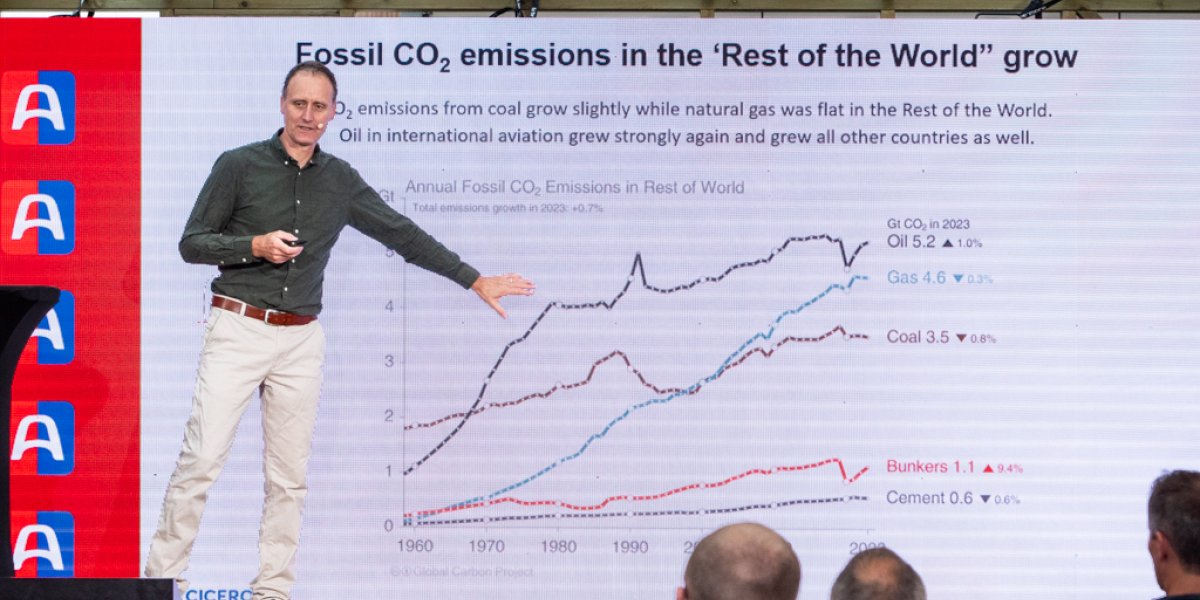Senior researchers Glen Peters from CICERO presented projected emissions growth for 2024 at Arendalsuka in Norway 13 August. Photo: Eilif Ursin Reed/CICERO
Global fossil CO₂ emissions are projected to continue to rise in 2024
Despite rapid growth in renewable energy production, fossil fuel use continues to rise, potentially pushing global fossil co₂ emissions up 0.6% in 2024. To remain consistent with the goals in the Paris Agreement, global co₂ emissions should be falling by more than five percent per year.
Senior researcher Glen Peters at CICERO Center for International Climate Research says data for the first half of the year suggests global fossil CO2 emissions will rise ~0.6% in 2024. The estimate is based on the latest reports from the International Energy Agency (coal and gas) and the US Energy Information Agency (oil).
“Many have predicted global fossil CO2 emissions are set to peak, but data for the first half of 2024 paints a different picture”, said Peters, who presented this estimate at an event organised by CICERO at Arendaluka in Norway Tuesday 13 August at 08:00 CEST (link to recording from the event here).
Global fossil CO2 emissions can fluctuate up and down from year to year, based on global economic conditions. Whilst the growth of clean technologies has been impressive, it is still not sufficient to overcome growth in fossil fuel use in many countries. This means fossil CO2 emissions continue to rise.
"To reach pathways consistent with the goals in the Paris Agreement, global CO₂ emissions should be falling more than five percent per year globally", said Peters.
“Despite the fast growth of renewables, coal, oil and gas still dominate the global energy system”, said Peters. Wind and solar are growing rapidly, as is the deployment of electric cars and battery storage, but the growth needs to pick up in more countries to displace fossil fuel use.
“In developed countries with stable energy use and older fossil fuel infrastructure, we see renewables displacing fossil fuel use and pushing CO2 emissions down,” said Peters. “In developing countries, with strong and needed growth in energy use, even rapid growth in renewables is not enough to keep up, meaning fossil fuel use also rises”.
“Without rapid renewable energy deployment, fossil CO2 emissions would be growing even faster,” noted Peters.
“Everyone needs to lift their game: developed countries have to reduce emissions faster, while developing countries need to slow down emission growth and peak emissions as soon as possible”.
“Each year of continued emissions locks the world into even more climate impacts, and it is necessary to get emissions to zero as fast as possible,” said Peters.
The main sources for emissions are energy consumption (electricity and heating), transport (cars, planes), manufacturing, construction and food production.
This analysis is based on data for the first half of 2024, with an updated and more detailed analysis to be released with the annual Global Carbon Budget in November 2024.
Follow updates from the Global Carbon Project https://www.globalcarbonproject.org/
CICERO organised an event at Arendalsuka about where global emissions are heading with updates from Glen Peters, senior reseracher at CICERO. Photo: Eilif Ursin Reed/CICERO
